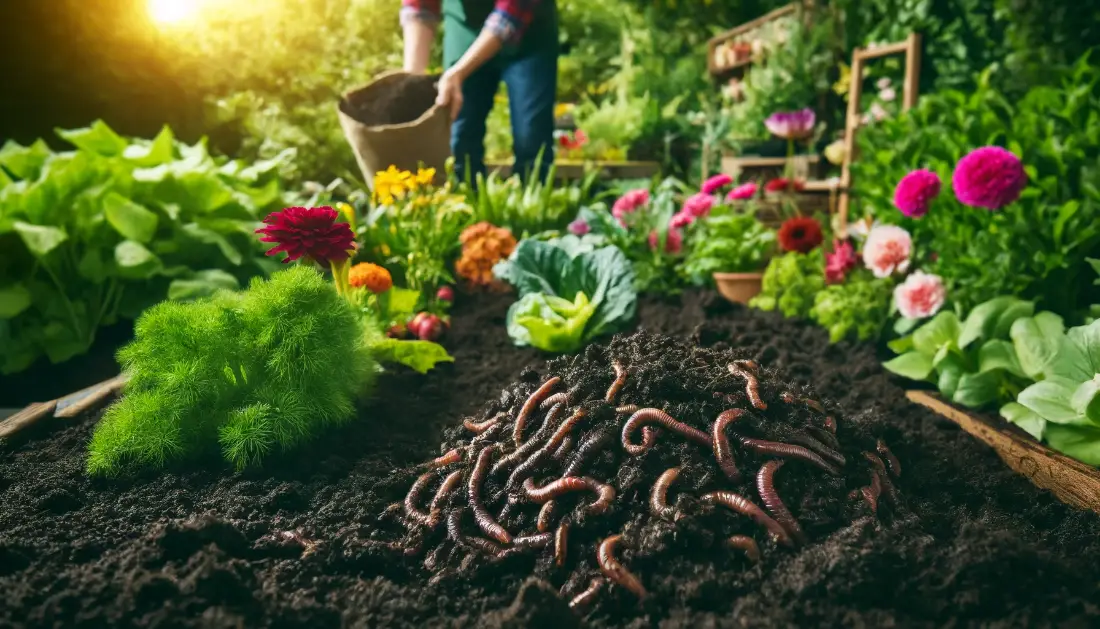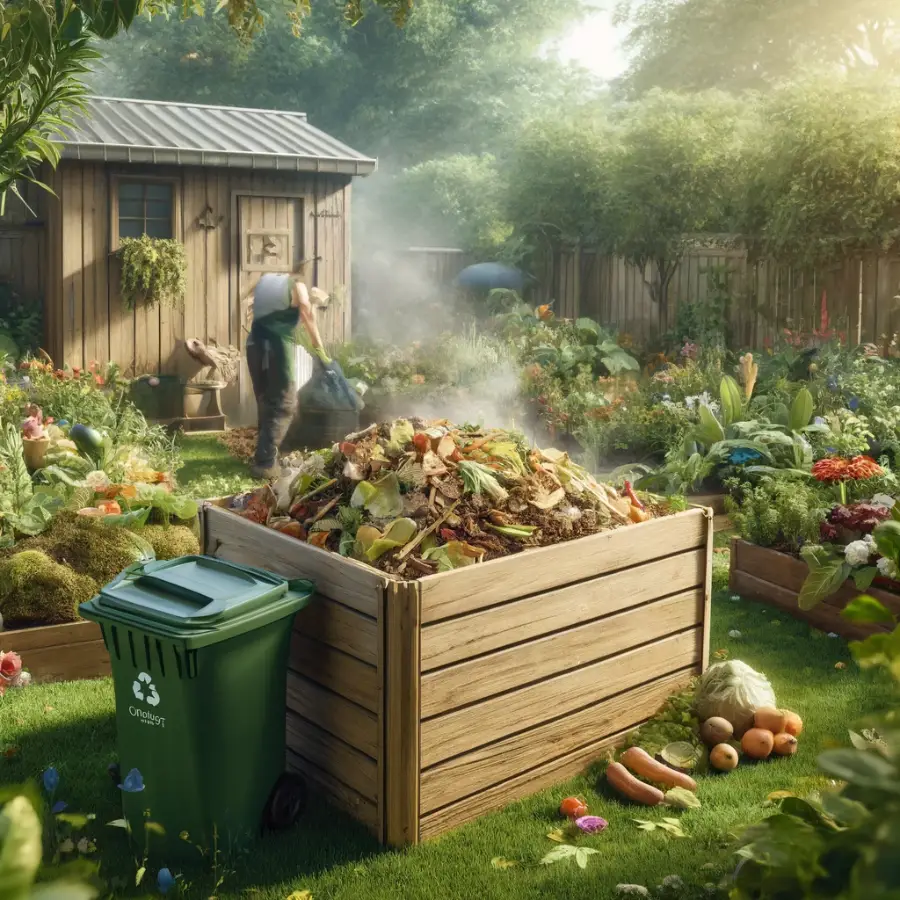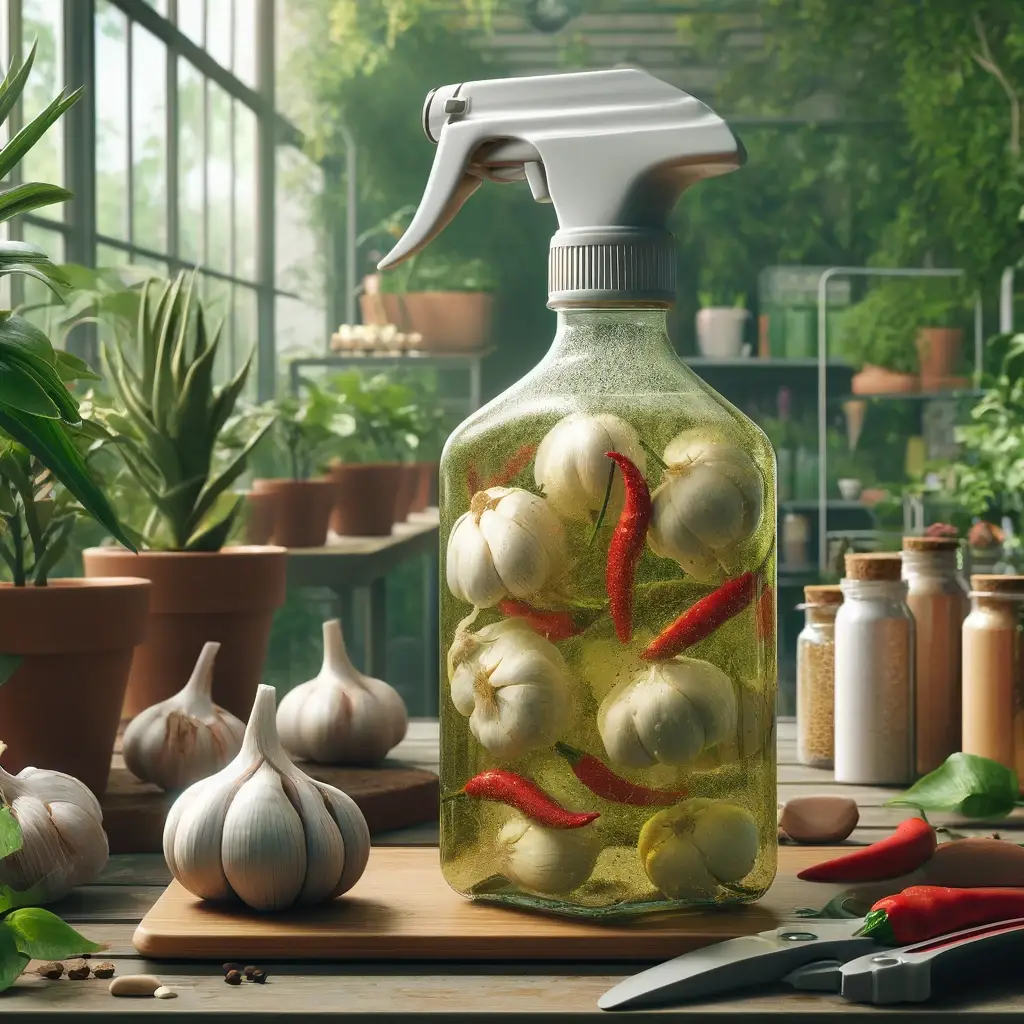Worm castings, also known as vermicompost, are a natural and nutrient-rich fertilizer produced by worms as they break down organic matter. Using worm castings in your garden can have numerous benefits for soil health, plant growth, and the environment.
Derived from the humble earthworm’s digestive processes, worm castings, often referred to as “black gold” by seasoned gardeners, offer a potent blend of nutrients, beneficial microorganisms, and organic matter that can transform even the most lackluster soil into a fertile haven for plant growth.
Benefits of Using Worm Castings
Worm castings offer a myriad of benefits to both the soil and the plants it nourishes. From enriching soil fertility to promoting robust plant growth, here’s why incorporating worm castings into your gardening routine is a game-changer:
Soil Improvement
Enhancing Soil Structure and Aeration:
- Worm castings contain a high percentage of organic matter, which helps to improve soil structure by binding soil particles together. This leads to increased soil aggregation, creating pore spaces that enhance aeration and water infiltration.
- Improved soil structure encourages root penetration and proliferation, allowing plants to access nutrients and water more efficiently. This results in healthier root systems and overall plant vigor.
Increasing Water Retention and Drainage:
- The organic matter present in worm castings acts like a sponge, retaining moisture in the soil and reducing water runoff. This helps to create a more stable moisture environment for plants, particularly during periods of drought.
- Additionally, the improved soil structure facilitated by worm castings promotes better drainage, preventing waterlogging and reducing the risk of root rot and other water-related issues.
Nutrient Enrichment
Providing Essential Macro and Micronutrients:
- Worm castings are a rich source of essential plant nutrients, including nitrogen, phosphorus, potassium, calcium, magnesium, and various trace elements. These nutrients are present in forms readily available for plant uptake, promoting healthy growth and development.
- Unlike synthetic fertilizers, which can leach away or become bound in the soil, the nutrients in worm castings are released slowly over time, ensuring a steady supply to plants without the risk of nutrient imbalances or environmental pollution.
Improving Nutrient Availability to Plants:
- The organic matter in worm castings serves as a reservoir of nutrients, releasing them gradually as it decomposes. This process is facilitated by beneficial microorganisms present in the castings, which break down organic matter and convert nutrients into forms that are readily accessible to plant roots.
- By improving nutrient availability, worm castings help to optimize plant growth, flowering, and fruiting, resulting in higher yields and better-quality produce.
Biological Activity
Introducing Beneficial Microorganisms:
- Worm castings are teeming with beneficial bacteria, fungi, and other microorganisms that contribute to soil health and fertility. These microorganisms play essential roles in nutrient cycling, organic matter decomposition, and disease suppression.
- When applied to the soil, worm castings inoculate the environment with a diverse microbial community, enhancing soil biodiversity and resilience to stress. This, in turn, promotes healthier plants with increased resistance to pests, diseases, and environmental fluctuations.
Suppressing Harmful Pathogens and Pests:
- The presence of beneficial microorganisms in worm castings can help to suppress soil-borne pathogens and pests, reducing the need for chemical pesticides and fungicides.
- Certain microorganisms found in worm castings produce compounds that inhibit the growth of harmful pathogens, such as fungi, nematodes, and harmful bacteria. This natural form of disease control contributes to a safer and more sustainable gardening ecosystem.
In summary, the use of worm castings offers a holistic approach to soil and plant health, addressing key aspects such as soil structure, nutrient availability, and biological activity. By harnessing the power of these natural amendments, gardeners can create thriving gardens that are both productive and environmentally sustainable.
Preparation
Before incorporating worm castings into your garden, it’s essential to understand how to acquire or produce them and estimate the quantity needed for your gardening needs.
Purchasing Worm Castings:
- Many garden centers, nurseries, and online suppliers offer high-quality worm castings for purchase. Look for reputable suppliers that produce castings from organic feedstocks and employ sustainable practices.
- Consider factors such as cost, packaging size, and shipping options when selecting a supplier. It’s often more economical to purchase worm castings in bulk for larger gardening projects.
Creating Your Own Worm Composting System:
- If you’re interested in a DIY approach, consider setting up a worm composting (vermicomposting) system at home. This allows you to recycle organic kitchen scraps and yard waste into nutrient-rich worm castings.
- Research different vermicomposting methods, such as bin composting or outdoor worm beds, and choose the one that best suits your space, time, and resource constraints.
- Obtain red worms (Eisenia fetida or Lumbricus rubellus), also known as composting worms, to populate your vermicomposting system. These worms are voracious decomposers and thrive in organic-rich environments.
Assessing Garden Size and Plant Needs:
- Evaluate the size and type of your garden, as well as the specific needs of your plants, to determine the quantity of worm castings required.
- As a general guideline, aim for a uniform application rate of 10-20% worm castings by volume when amending garden soil. Adjust the application rate based on soil fertility levels, plant preferences, and desired outcomes.
Calculating Quantity Needed:
- Measure the area of your garden beds or containers in square feet or cubic yards, depending on the application method.
- Multiply the area by the desired application rate (e.g., 10-20%) to calculate the volume of worm castings needed in cubic feet or cubic yards.
- Alternatively, if using worm castings for specific plants or containers, estimate the volume of soil or growing medium and adjust the application rate accordingly.
Inspecting Worm Castings:
- Whether purchasing or producing worm castings, visually inspect the product to ensure its quality and consistency.
- High-quality worm castings should have a crumbly texture, earthy aroma, and dark, uniform color. Avoid products with offensive odors, excessive moisture, or visible signs of contamination.
Testing for Purity and Contaminants:
- If purchasing worm castings from an unfamiliar source, consider conducting a simple purity test to check for contaminants such as debris, pathogens, or chemical residues.
- Perform a small-scale trial by mixing a sample of worm castings with water and observing for any unusual odors, colors, or sedimentation. Consult with local agricultural extension services or soil testing laboratories for comprehensive analysis if needed.
Application Methods
Once you’ve acquired or produced high-quality worm castings and estimated the quantity needed for your gardening project, it’s time to explore different application methods to effectively incorporate worm castings into your garden soil and plant care routines.
Direct Soil Application
Mixing Worm Castings into the Soil:
- Prepare the garden bed by loosening the soil with a garden fork or tiller to a depth of 6-8 inches.
- Spread a layer of worm castings evenly over the soil surface, aiming for a thickness of 1-2 inches.
- Incorporate the worm castings into the soil using a garden rake or shovel, ensuring thorough mixing throughout the root zone of plants.
- Water the soil lightly to help settle the castings and initiate nutrient release.
Applying as a Top Dressing Around Plants:
- For established plants, spread a thin layer of worm castings around the base of each plant, extending to the drip line.
- Avoid direct contact with plant stems to prevent moisture-related issues and stem rot.
- Gently work the castings into the soil surface using a hand trowel or cultivator, taking care not to disturb the plant roots.
- Water the soil after application to promote nutrient absorption and microbial activity.
Seed Starting and Transplanting
Incorporating Worm Castings into Seed Starting Mixtures:
- Mix worm castings with seed starting mix or potting soil at a ratio of 10-20%, depending on the desired nutrient content.
- Fill seed trays, pots, or seedling containers with the prepared mixture, leaving space for seed sowing or transplanting.
- Plant seeds at the recommended depth and spacing, covering them lightly with additional potting mix if necessary.
- Water the seedlings gently to avoid displacing the soil mixture, maintaining adequate moisture for germination and seedling growth.
Adding Worm Castings to Transplant Holes:
- Prior to transplanting seedlings or new plants, dig planting holes of appropriate size and spacing.
- Mix worm castings with native soil or backfilling material at a ratio of 10-20% to enrich the planting hole.
- Place the root ball of the transplant into the prepared hole, ensuring proper alignment and depth.
- Backfill the hole with the amended soil mixture, firming gently around the roots to eliminate air pockets.
- Water the transplants thoroughly to settle the soil and establish good root-to-soil contact.
Compost Tea
Brewing Compost Tea with Worm Castings:
- Fill a large container, such as a bucket or barrel, with water (preferably non-chlorinated) and let it sit overnight to dechlorinate.
- Add a generous amount of worm castings to a mesh bag or filter sock and suspend it in the water.
- Agitate the mixture periodically to encourage microbial activity and nutrient extraction from the castings.
- Brew the compost tea for 24-48 hours, aerating continuously with an air pump and air stone to maintain oxygen levels.
- Strain the finished compost tea to remove solid particles, then dilute it with water to the desired concentration (usually 1:10 to 1:20).
- Apply the compost tea as a foliar spray or root drench to plants, promoting nutrient uptake, disease suppression, and overall plant health.
Best Practices and Tips for Using Worm Castings
Incorporating worm castings into your garden can yield significant benefits for soil health and plant growth. To maximize their effectiveness and ensure optimal results, consider the following best practices and tips:
Storage and Shelf Life
Proper Storage Conditions:
- Store worm castings in a cool, dry place away from direct sunlight to prevent degradation of nutrients and microbial activity.
- Use airtight containers or resealable bags to minimize exposure to air and moisture, which can compromise quality over time.
Shelf Life Considerations:
- While worm castings have an indefinite shelf life when stored correctly, fresher castings tend to retain more active microbial populations and nutrient content.
- Rotate stock regularly to use older worm castings first and ensure a steady supply of fresh castings for ongoing gardening needs.
Application Frequency
Guidelines for Regular Application:
- Apply worm castings to garden soil or container plants on a regular basis to maintain soil fertility and support plant growth throughout the growing season.
- Incorporate worm castings into your garden maintenance schedule, such as during soil preparation, seed starting, transplanting, and monthly top dressings.
Monitoring Plant Response:
- Observe the response of plants to worm castings application, including changes in growth rate, foliage color, flowering, and fruiting.
- Adjust the frequency and quantity of worm castings applied based on plant needs, soil conditions, and seasonal variations in nutrient availability.
Combination with Other Amendments
Synergies with Organic Fertilizers and Soil Amendments:
- Combine worm castings with other organic fertilizers, such as compost, composted manure, or seaweed extract, to create a balanced nutrient profile for plants.
- Experiment with different combinations of soil amendments to enhance soil fertility, improve soil structure, and promote microbial diversity.
Avoiding Overuse and Maintaining Balance:
- While worm castings are beneficial, excessive application can lead to nutrient imbalances or salt buildup in the soil.
- Follow recommended application rates and avoid overloading plants with nutrients, especially nitrogen, which can cause excessive vegetative growth at the expense of fruiting or flowering.
Soil Testing and Monitoring
Periodic Soil Testing:
- Conduct soil tests periodically to assess nutrient levels, pH, and other soil properties that may influence plant growth and productivity.
- Use soil test results to guide amendments and adjustments to your gardening practices, including the application of worm castings and other soil amendments.
Visual Inspection and Plant Health Checks:
- Regularly inspect plants for signs of nutrient deficiencies, pest infestations, or disease symptoms that may indicate underlying soil or environmental issues.
- Address any issues promptly through targeted interventions, such as additional fertilizer applications, pest management strategies, or adjustments to watering and drainage.
Environmental Considerations
Sustainable Gardening Practices:
- Embrace sustainable gardening practices that prioritize soil health, biodiversity, and environmental stewardship.
- Use organic and natural amendments, such as worm castings, compost, and mulch, to reduce reliance on synthetic chemicals and minimize environmental impact.
FAQs about using worm castings in gardening:
What are worm castings, and how are they produced?
Worm castings are the nutrient-rich organic matter produced by earthworms as they digest organic materials. They are created through a process called vermicomposting, where worms consume organic waste and excrete nutrient-dense castings.
What are the benefits of using worm castings in my garden?
Worm castings improve soil structure, enhance water retention and drainage, enrich soil with essential nutrients, promote beneficial microbial activity, and suppress harmful pathogens and pests. They support healthy plant growth, increase yields, and contribute to overall soil health and fertility.
How do I apply worm castings to my garden?
Worm castings can be applied directly to the soil by mixing them into the planting beds or applying them as a top dressing around plants. They can also be incorporated into seed starting mixtures, transplant holes, or brewed into compost tea for foliar application or root drenching.
How much worm castings should I use in my garden?
The recommended application rate of worm castings varies depending on factors such as soil type, plant type, and specific gardening goals. As a general guideline, aim for a uniform application rate of 10-20% by volume when amending garden soil or potting mixtures.
Are worm castings safe to use around children and pets?
Yes, worm castings are safe and non-toxic for children, pets, and wildlife. They are free from harmful chemicals and pathogens, making them an eco-friendly and pet-friendly option for gardeners concerned about environmental and health impacts.
Can I use worm castings in organic gardening?
Yes, worm castings are an approved amendment for organic gardening practices. They meet the criteria for organic certification standards and are widely recognized as a natural and sustainable way to improve soil fertility and plant health without the use of synthetic chemicals or genetically modified organisms (GMOs).
Do worm castings have an expiration date?
Worm castings have an indefinite shelf life when stored properly in a cool, dry place away from direct sunlight. While they do not spoil or degrade over time, fresher castings may contain higher levels of active microbial populations and nutrients compared to older castings.
Can I use worm castings with other fertilizers and soil amendments?
Yes, worm castings can be combined with other organic fertilizers, compost, and soil amendments to create a balanced nutrient profile and enhance soil health. Experiment with different combinations to tailor soil amendments to your specific gardening needs and preferences.
Are there any plants that do not benefit from worm castings?
Worm castings are beneficial for a wide range of plants, including vegetables, fruits, herbs, flowers, ornamentals, and houseplants. However, some specialized plants may have specific soil requirements or preferences that may not necessitate the use of worm castings.
Where can I purchase worm castings for my garden?
Worm castings are available for purchase from garden centers, nurseries, farm supply stores, and online suppliers. Look for reputable suppliers that produce high-quality worm castings from organic feedstocks and employ sustainable vermicomposting practices.









